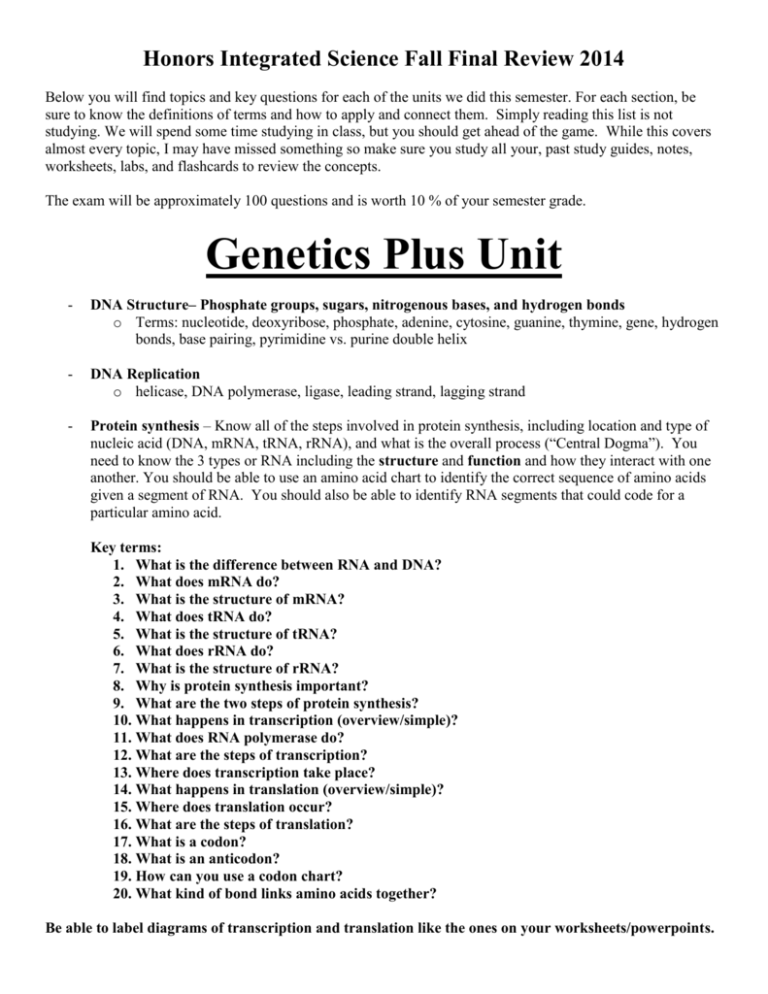Honors Integrated Science Fall Final Review 2014
advertisement

Honors Integrated Science Fall Final Review 2014 Below you will find topics and key questions for each of the units we did this semester. For each section, be sure to know the definitions of terms and how to apply and connect them. Simply reading this list is not studying. We will spend some time studying in class, but you should get ahead of the game. While this covers almost every topic, I may have missed something so make sure you study all your, past study guides, notes, worksheets, labs, and flashcards to review the concepts. The exam will be approximately 100 questions and is worth 10 % of your semester grade. Genetics Plus Unit - DNA Structure– Phosphate groups, sugars, nitrogenous bases, and hydrogen bonds o Terms: nucleotide, deoxyribose, phosphate, adenine, cytosine, guanine, thymine, gene, hydrogen bonds, base pairing, pyrimidine vs. purine double helix - DNA Replication o helicase, DNA polymerase, ligase, leading strand, lagging strand - Protein synthesis – Know all of the steps involved in protein synthesis, including location and type of nucleic acid (DNA, mRNA, tRNA, rRNA), and what is the overall process (“Central Dogma”). You need to know the 3 types or RNA including the structure and function and how they interact with one another. You should be able to use an amino acid chart to identify the correct sequence of amino acids given a segment of RNA. You should also be able to identify RNA segments that could code for a particular amino acid. Key terms: 1. What is the difference between RNA and DNA? 2. What does mRNA do? 3. What is the structure of mRNA? 4. What does tRNA do? 5. What is the structure of tRNA? 6. What does rRNA do? 7. What is the structure of rRNA? 8. Why is protein synthesis important? 9. What are the two steps of protein synthesis? 10. What happens in transcription (overview/simple)? 11. What does RNA polymerase do? 12. What are the steps of transcription? 13. Where does transcription take place? 14. What happens in translation (overview/simple)? 15. Where does translation occur? 16. What are the steps of translation? 17. What is a codon? 18. What is an anticodon? 19. How can you use a codon chart? 20. What kind of bond links amino acids together? Be able to label diagrams of transcription and translation like the ones on your worksheets/powerpoints. - Compounds in living things – Be able to identify the types of compounds found in living things and some of the basic characteristics, functions, and differences between them. o Terms: organic/inorganic, polymerization, dehydration synthesis, hydrolysis, carbohydrate, lipid, protein, nucleic acid (Know the CHO-CHO-HONC-PONCH chart), enzymes (know the structure and function and what makes them so specific.), monomers, polymers. - Mendel, genetics, and Punnett squares – How did Mendel’s experiments with pea plants lead to our current understanding of genetics? Be able to create and interpret Punnett squares to demonstrate a cross between organisms. What types of mutations can occur in humans and what are their effects. o Terms: self-fertilization vs. cross-fertilization, genotype, phenotype, trait, gene, allele, Mendel’s three principles: segregation, independent assortment, dominance. Gametes (know sex cells vs. body cells and how they are formed), co-dominance, homozygous dominant, heterozygous, homozygous recessive, hybrid, purebred, dihybrid/two factor cross, reading and interpreting a pedigree, sex-linked traits/disorders, mitosis vs. meiosis (outcome/phases-chapter 16, fig. 15). Biotechnology Topics General Biotech Recombinant DNA: what is it? Steps to create it? What are transgenic organisms? Plasmids: what are they? Where are they found? Why do we use them in biotechnology? Genetic engineering: definition, examples, why is bacteria the preferred tool in biotech? Restriction enzymes: what are they? What do they do? What types of cuts can they make? Where did they originate from? What are recognitions sites? How are they important to recombinant DNA? How are they important to gel electrophoresis Applications of Biotech: you need to know the process of using each of the following, what it can be used for, and its pros and cons. -Genetically Modified organisms (plants and animals) -stem cell research (all 3 types of stem cells) -DNA in crime solving (gel electrophoresis/DNA Fingerprinting -Cloning (reproductive and therapeutic cloning -In Vitro Fertilization (sex selection and pre-implantation genetic diagnosis)











